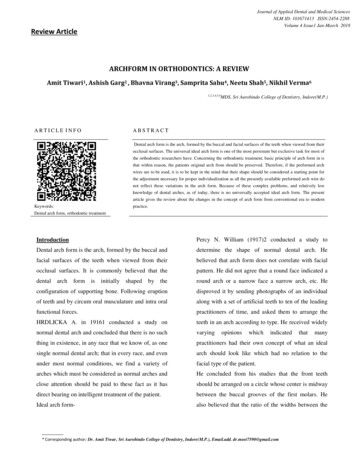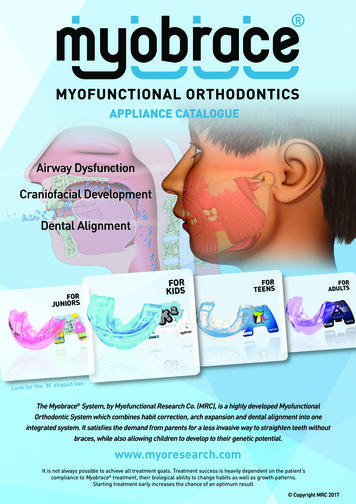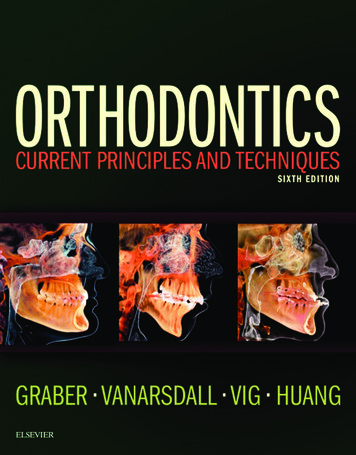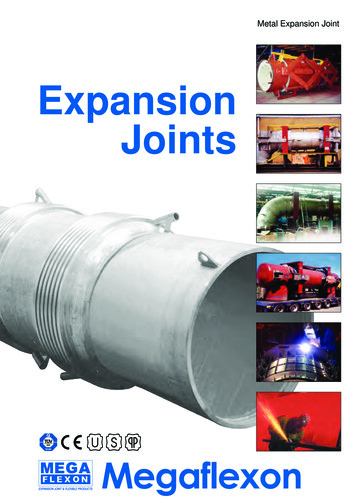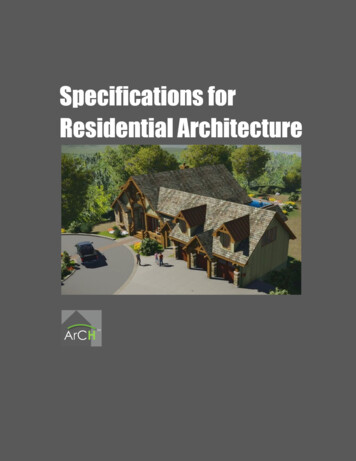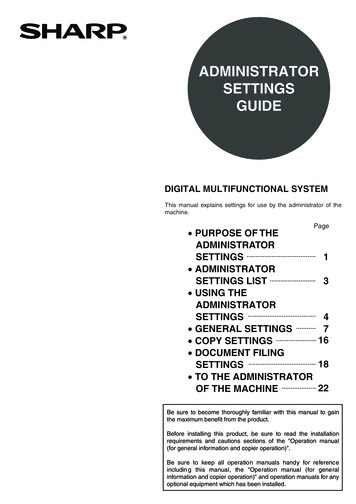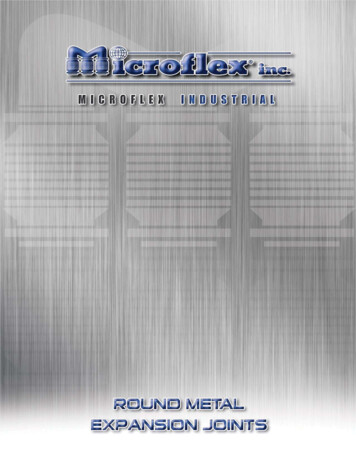
Transcription
ARCH EXPANSIONINORTHODONTICSDEPARTMENT OF ORTHODONTICSSUBHARTI DENTAL COLLEGESWAMI VIVEKANAND SUBHARTI UNIVERSITYPresented By:Dr Shalu Jain
INTRODUCTION Arch Expansion is a method of gaining spacein Orthodontics. It is one of the oldest and most conservativemethod of gaining space. It can be used to correct intermaxillary anddental arch relationships primarily in thetransverse direction. It also enables correctionof crossbites early in treatment.DrShalu Jain, Subharti Dental College, SVSU
Classification1. Orthodontic or dental expansiondentoalveolar in nature and produced byvarious removable expansion plates andconventional fixed appliances.There is lateral tipping of crown and lingualtipping of roots.2. Orthopedic or skeletal expansion- Changesproduced are skeletal in nature.Eg- Rapid maxillary expansion.DrShalu Jain, Subharti Dental College, SVSU
3. Passive Expansion- It is produced byshielding of buccal and labial muscles with aresultant expansion of the arches.This type of expansion is produced by intrinsicforces such as those produced by the tongue.Eg- Fr-2 appliance and lip bumper.DrShalu Jain, Subharti Dental College, SVSU
ANATOMYThe maxilla is a paired bone that articulates with itsopposite member and various other bones incl frontal,ethmoid, nasal, lacrimal, vomer, zygomatic and the palatinebones.Most of the sutural attachments of the maxilla to theadjoining bones are at its posterior and superior aspectsleaving the anterior and inferior aspects free, which makesit vulnerable for lateral displacement.DrShalu Jain, Subharti Dental College, SVSU
The inter-maxillary and the inter-palatine sutures arecollectively called the mid-palatal suture.DrShalu Jain, Subharti Dental College, SVSU
Mid Palatine Suture plays a key role inR.M.E.i. Infancy - Y-shapeii. Juvenile - T-shapeiii. Adolescence - Jigsaw puzzleAs sutural patency is vital to R.M.E, it isimportant to know when does the suturecloses by synostosisAn average 5% of suture in closed by age25 yrs, range of ossification between 15-27yearsEarliest closure occurs in girls aged 15 yrsand 18 years in boys.Greater degree of obliteration occursposteriorly than anteriorly.DrShalu Jain, Subharti Dental College, SVSU
Alsoknown as rapid palatal expansion orsplit palate. It is a skeletal type of expansion thatinvolves the separation of the mid-palatalsutures and movement of the maxillaryshelves away from each other. Emerson C. Angell is considered the fatherof rapid maxillary expansion.DrShalu Jain, Subharti Dental College, SVSU
INDICATIONS OF RAPID MAXILLARYEXPANSION Posterior crossbites Class III malocclusion- Dental orskeletal cause. Cleft Palate patients Face mask therapy Medical indications- Nasal stenosis,poor nasal airway, septal deformities,allergic rhinitis. Selected arch lenghth problems- Inselected patients in whom extractioncould lead to flatteningof profile.DrShalu Jain, Subharti Dental College, SVSU
TYPES OF APPLIANCES USEDFixed appliances- (a) Tooth borne(b)Tooth & Tissue borneDrShalu Jain, Subharti Dental College, SVSU
FIXED APPLIANCES Appliances that are fixed onto the teeth are morereliable and found to produce consistent skeletaleffects. TOOTH AND TISSUE BORNE APPLIANCES1. Derichsweiler type2. Hass typeTOOTH BORNE APPLIANCES1. Isaacson type2. Hyrax typeDrShalu Jain, Subharti Dental College, SVSU
1. Derichsweiler type- The first premolars andfirst molars are banded. Wire tags aresoldered onto the palatal aspect of the band.These wire tags get inserted into a splitacrylic plate incorporating a screw at itscentre.DrShalu Jain, Subharti Dental College, SVSU
2. Hass type- The 1st premolar and molar ofeither side are banded. A thick stainless steelwire is soldered on the buccal and lingualaspect connecting PM and M bands. Thelingual wire is kept longer to extend past thebands. The split palatal acrylic has a midlinescrew.DrShalu Jain, Subharti Dental College, SVSU
3. Isaacson type- This a tooth borneappliance without any acrylic palatalcovering. This design makes use of aspring loaded screw called a minneexpander.DrShalu Jain, Subharti Dental College, SVSU
4. Hyrax type- This type of appliancemakes use of a special type of screwcalled HYRAX ( Hygienic rapid expander).The screws have heavy gauge wireextensions that are adapted to follow thepalatal contour and are soldered to bandson premolars and molars.DrShalu Jain, Subharti Dental College, SVSU
EFFECT OF R.M.E. ON THE MAXILLARYCOMPLEX Rapid maxillary expansion occurs when the forceapplied to the teeth and the maxillary alveolarprocesses exceeds the limits needed for orthodontictooth movement. The applied pressure acts as an orthopaedic forcethat opens the midpalatal suture.DrShalu Jain, Subharti Dental College, SVSU
The appliance compresses the periodontalligament, bends the alveolar processes, tipsthe anchor teeth, and gradually opens themidpalatal suture.DrShalu Jain, Subharti Dental College, SVSU
OCCLUSAL VIEW Palatine processes of the maxillae separatedin a nonparallel— that is, in a wedge-shapedDrShalu Jain, Subharti Dental College, SVSU
FRONTAL VIEW The maxillary suture was found to separatesuperoinferiorly in a nonparallel manner. It is pyramidal in shape with the base of thepyramid located at the oral side of the bone.DrShalu Jain, Subharti Dental College, SVSU
MAXILLARY ANTERIOR TEETH From the patient's point of view, one of themost spectacular changes accompanying RMEis the opening of a diastema between themaxillary central incisors.DrShalu Jain, Subharti Dental College, SVSU
EFFECT OF R.M.E. ON MANDIBULARCOMPLEX The mandible rotates downward and backwards due to thedownward movement of the maxillary posterior teeth in abuccal direction. The palatal cusps of the maxillary posterior teeth, whichshould ideally occlude in the occlusal grove of themandibular posterior teeth, tend to occlude with thelingual slopes of the buccal cusps of these teeth, there bygiving the effect of opening the biteDrShalu Jain, Subharti Dental College, SVSU
DrShalu Jain, Subharti Dental College, SVSU
EFFECT OF R.M.E. ON THE NASAL CAVITY The RME tends to increase the intranasalspace as the outer walls of the nasal cavitymove apart and the palatal shelves flatten out,making the nasal floor broader.DrShalu Jain, Subharti Dental College, SVSU
ACTIVATION OF THE RME APPLIANCE Forces generated are close to 10 to 20 pounds. An expansion of 0.2 to 0.5 mm should beachieved per day. Screw activated at between 0.5 to 1mm per dayand about 1 cm of expansion can be expected in2 to 3 weeksDrShalu Jain, Subharti Dental College, SVSU
Timms - activation of 90 ,morning and evening - patientsup to age of 15 yearsIn patients above this age- suggests an activation of 45 four times a day. Zimring and lsaacson recommended, two turns per dayinitial 4 to 5 days followed by one turn per day in growingindividuals.For adults : two turns each for the first two days followedby one turn per day for the next 5 to 7 days and then onlyone turn every alternate day till the desired expansion isachieved.DrShalu Jain, Subharti Dental College, SVSU
1.2.3.4.Single tooth crossbitesUncooperative patientsRME is not carried out after ossification of themidpalatal suture unless accompanied byadjunctive surgical procedures.Vertical growers with steep mandibular plane.Dr Shalu Jain, Subharti Dental College, SVSU
5. Skeletal asymmetry of maxilla and mandibleand adult cases with severe antero-posteriorskeletal discrepancies.6. Periodontally weak dentition.DrShalu Jain, Subharti Dental College,SVSU
Oral hygiene Length of fixation Dislodgement and breakage Tissue damage Infection Failure of suture to openDr Shalu Jain, Subharti Dental College, SVSU
SURGICALLY ASSISTED RAPID PALATALEXPANSION (SARPE)Patients who exhibit unusual resistance to separationof palatine bones may require surgical intervention.This usually occurs in female patients over 16 yearsof age and male patients over 18 years of age.It may also be required in patients exhibiting increasedcircum maxillary rigidity as a result of aging.DrShalu Jain, Subharti Dental College, SVSU
The main resistance to maxillary skeletalexpansion comes from the buttressing effectof zygomatic and sphenoid bones at theirpoint of attachment to the maxilla.SARPE involves surgical separation of theseattachments thereby allowing expansion to beachieved using a conventional RME appliance.Expansion is carried out at a rate of 0.5mm perday. It has a high relapse tendency becauseof inelasticity of palatal mucoperiosteum anda degree of overcorrection is valuable.DrShalu Jain, Subharti Dental College, SVSU
in Orthodontics. It is one of the oldest and most conservative method of gaining space. It can be used to correct intermaxillary and dental arch relationships primarily in the transverse direction. It also enables correction of crossbites early in treatment. DrShalu Jain, Subharti Dental College, SVSU


